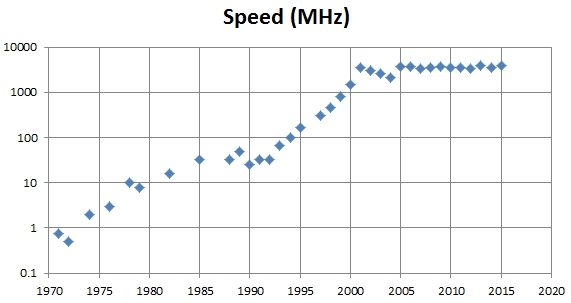https://en.wikipedia.org/wiki/Clock_rate
As of 2011, the Guinness World Record for fastest CPU is by AMD with a Bulldozer based FX chip “overclocked” to 8.805 GHz, trumping the maximum recorded 8.670 GHz performance of their next generation FX “Piledriver” chips.
As of mid-2013, the highest clock rate on a production processor is the IBM zEC12, clocked at 5.5 GHz, which was released in August of 2012.
Engineers continue to find new ways to design CPUs that settle a little more quickly or use slightly less energy per transition, pushing back those limits, producing new CPUs that can run at slightly higher clock rates. The ultimate limits to energy per transition are explored in reversible computing, although no reversible computers have yet been implemented.
The first fully reversible CPU, the Pendulum, was implemented using standard CMOS transistors in the late 1990s at MIT.
Engineers also continue to find new ways to design CPUs so that they complete more instructions per clock cycle, thus achieving a lower CPI (cycles or clock cycles per instruction) count, although they may run at the same or a lower clock rate as older CPUs. This is achieved through architectural techniques such as instruction pipelining and out-of-order execution which attempts to exploit instruction level parallelism in the code.
See also: Moore’s law
https://en.wikipedia.org/wiki/Moore%27s_law
Moore’s law (/mɔərz.ˈlɔː/) is the observation that the number of transistors in a dense integrated circuit doubles approximately every two years. The observation is named after Gordon E. Moore, the co-founder of Intel and Fairchild Semiconductor, whose 1965 paper described a doubling every year in the number of components per integrated circuit, and projected this rate of growth would continue for at least another decade. In 1975, looking forward to the next decade, he revised the forecast to doubling every two years.
His prediction proved accurate for several decades, and the law was used in the semiconductor industry to guide long-term planning and to set targets for research and development. Advancements in digital electronics are strongly linked to Moore’s law: quality-adjusted microprocessor prices, memory capacity, sensors and even the number and size of pixels in digital cameras.
